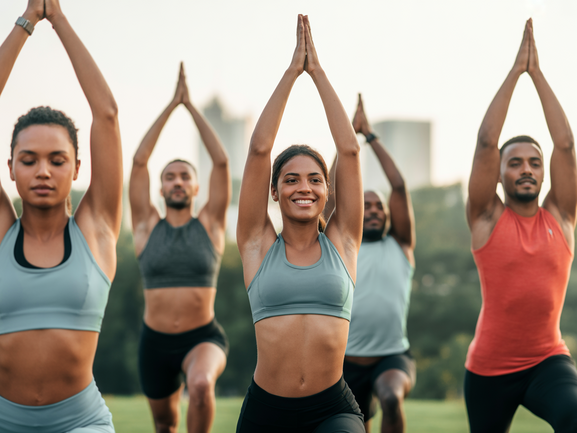How Yoga Transforms Athletic Performance for Amateur Athletes
Whether you’re training for your first 5K or pushing toward a personal best in cycling, the secret to unlocking your athletic potential might not be found in the gym or on the track. Instead, it could be waiting for you on a yoga mat.
Yoga for athletes isn’t just a trendy wellness practice—it’s a game-changing tool that transforms how you move, recover, and perform. In fact, professional sports teams across the globe now integrate yoga into their training programs, and amateur athletes are discovering these same benefits.
Ready to revolutionize your training routine? Let’s explore how this ancient practice can elevate your athletic journey to new heights.
The Science Behind Yoga and Athletic Enhancement
Research consistently demonstrates that yoga injury prevention isn’t just wishful thinking—it’s backed by solid science. A 2021 study published in the International Journal of Yoga found that athletes who practiced yoga showed significant improvements in flexibility, balance, and core strength.
Moreover, the practice enhances proprioception—your body’s ability to sense its position in space. This heightened body awareness translates directly to better movement mechanics and reduced injury risk during your favorite activities.
Here’s what happens in your body when you combine yoga with athletic training:
- Improved muscle elasticity: Regular stretching through yoga poses increases muscle fiber length
- Enhanced circulation: Better blood flow accelerates recovery between training sessions
- Stress hormone regulation: Mindful breathing reduces cortisol levels that can hinder performance
- Nervous system balance: Activates the parasympathetic nervous system for optimal recovery
The beauty of sports performance yoga lies in its ability to address the specific needs of active individuals. Unlike traditional stretching routines, yoga provides a comprehensive approach that targets both physical and mental aspects of athletic performance.
Essential Yoga Poses Every Amateur Athlete Should Master
Not all yoga poses are created equal when it comes to athlete flexibility training. These fundamental poses address the most common tight spots and imbalances that plague amateur athletes:
1. Downward Facing Dog (Adho Mukha Svanasana)
This foundational pose stretches the entire posterior chain—calves, hamstrings, and shoulders—while strengthening the core and arms. Perfect for runners dealing with tight calves or cyclists with rounded shoulders.
2. Warrior III (Virabhadrasana III)
Challenges your balance and strengthens the entire kinetic chain. This pose is particularly beneficial for developing the single-leg stability crucial in running and many sports.
3. Pigeon Pose (Eka Pada Rajakapotasana)
Targets the hip flexors and piriformis—muscles that often become tight from repetitive athletic movements. Essential for preventing IT band issues and lower back pain.
4. Thread the Needle
Improves thoracic spine mobility, counteracting the forward head posture common in many sports. Particularly valuable for swimmers and cyclists.
Want to learn these poses with proper alignment and modifications for your specific sport? The Vitalizen.app platform offers athlete-specific sequences that guide you through each pose safely and effectively.
Building a Sustainable Yoga Practice Around Your Training Schedule
The biggest challenge isn’t learning best yoga poses for runners or other athletes—it’s finding time to practice them consistently. However, integrating athlete recovery yoga into your routine doesn’t require major schedule overhauls.
Here’s a practical approach that works for busy amateur athletes:
The 10-Minute Morning Flow
Start your day with gentle movement to prepare your body for training. Focus on mobility and activation rather than deep stretching.
Post-Workout Recovery Sessions (15-20 minutes)
This is where yoga for sports recovery shines. Use cooling poses immediately after training to begin the recovery process while your muscles are still warm.
Weekly Deep Practice (30-45 minutes)
Dedicate one session per week to addressing deeper tension patterns and imbalances. This longer practice allows for more challenging poses and meditation.
The key is consistency over intensity. A short daily practice yields better results than sporadic long sessions. Through personalized programs, you can build a practice that complements rather than competes with your training schedule.
Success Stories: Real Athletes, Real Results
The proof is in the performance. Amateur athletes worldwide are discovering how yoga helps amateur athletes achieve breakthrough results:
“After six months of consistent yoga practice, my running form improved dramatically. I shaved 3 minutes off my half-marathon time and haven’t had a single injury this season.” – Sarah, recreational runner
“As a weekend cyclist, I used to struggle with hip tightness and lower back pain. Yoga didn’t just eliminate the pain—it made me stronger on the bike.” – Mike, cycling enthusiast
These aren’t isolated cases. The combination of improved flexibility, better body awareness, and enhanced recovery creates a compound effect that elevates overall athletic performance.
Many athletes find that working with structured programs helps them stay consistent and see faster results. The Vitalizen approach to yoga and movement specifically addresses the unique needs of active individuals, making it easier to stick with your practice.
Frequently Asked Questions
How often should athletes practice yoga?
For optimal benefits, aim for 3-4 yoga sessions per week. However, even 10 minutes daily can make a significant difference. The key is consistency rather than duration. Many successful athletes practice short sessions on training days and longer sessions on rest days.

